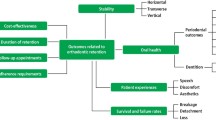Abstract
Data sources
Medline (Pubmed), Embase, Cochrane Database of Systematic Reviews, Cochrane Central Register of Controlled Trials, Google Scholar, Web of Science, Evidence-based Medicine, Scopus, LILACS database, Ovid database, Bibliografia Brasileira de Odontolgogia, Bandolier, Atypon Link, African Journals Online, ProQuest, Conference Paper Index, German National Library of Medicine, metaRegister of Controlled Trials.
Study selection
Randomised Controlled Trials (RCT) or prospective Controlled Clinical Trials (pCCT) in patients with Class II malocclusions that compared at least one removable functional appliance (RFA) with a non-intervention control. Primary outcomes were angular measurements of skeletal, dental and soft tissue changes as measured by lateral cephalographs.
Data extraction and synthesis
Two reviewers independently extracted data and assessed risk of bias. A third author assessed bias across studies. Pooling of data was done if similar control groups were used and if the same angular cephalometric measurements were reported. A random-effects model was used to analyse pooled estimates and results were expressed as mean differences (MDs) and 95% confidence intervals (CI). The extent and impact of heterogeneity was assessed.
Results
Data were pooled from seventeen studies (seven RCTs and ten pCCT) involving 1031 patients with a mean age of 10.6 years. Most of the RCTs were associated with high risk of bias while most of the pCCTs were without serious methodological limitations. RFA treatment in Class II malocclusions was shown to have a statistically significant short-term effect on skeletal, dental and soft tissue relationships when compared to untreated controls. There is a minimal reduction of SNA (MD=−0.26 degree/year, 95% CI=−0.44 to −0.12 degree/year), minimal increase of SNB (MD=0.62 degree/year, 95% CI=0.36 to 0.88 degree/year) and a small decrease in ANB (MD= −1.14degree/year, 95% CI=−1.52 to 0.77 degree/year). Maxillary incisors were significantly retroclined (1s-NL=−6.33 degree/year) while mandibular incisors were proclined (1i-ML=1.37 degree/year). Soft tissue cephalometric variables were significantly affected with mentolabial angle showing the biggest effect size (MD=22.6 degree/year; 95% CI = 18.31to 26.9 degree/year).
Conclusions
Evidence indicates that RFAs are effective in improving Class II malocclusions in the short term. While the skeletal changes are minimal, significant dentoalveolar retroclination of maxillary incisors and proclination of mandibular incisors and soft tissue changes occurred with RFAs.
Similar content being viewed by others
Commentary
Class II malocclusions, due to mandibular retrognathism, occur with high frequency and are often managed using removable functional appliances (RFAs). These appliances stimulate mandibular growth by holding it forward and have been shown to benefit growing patients. However, individual contributions of skeletal and dental changes following functional appliance therapy remain controversial. This well conducted review aims to summarise the evidence regarding effectiveness of RFAs in the treatment of Class II malocclusions, compared to untreated controls, using angular measurements from lateral cephalographs.
Two authors independently undertook an exhaustive search of the literature to include major electronic databases with no limits on language, status and year of publication. Primary authors were contacted as appropriate. Since the review was to evaluate therapeutic intervention, the authors correctly limited the included studies to randomised clinical trials (RCTs) and prospective controlled clinical trials (pCCTs). Additionally, by excluding studies without or inappropriate control (n=71), the authors increased the review's internal validity. Cochrane Collaboration's risk of bias assessment tool was used to evaluate RCTs while modified a Downs and Black checklist1 was used to evaluate pCCTs. Inter-examiner agreement, assessed by kappa statistic, was high for study selection, data extraction and risk of bias assessment.
Meta-analysis was performed using a random effects model for 15 skeletal, eight dental and five soft tissue angular measurements from lateral cephalographs. This is important because linear measurements are subject to magnification error and may bias the results.
Overall, there was a small restrictive effect on the maxilla, minimal mandibular growth, moderate improvement in maxilla-mandibular relationships and a small increase in mandibular plane angle. Significant retroclination of maxillary incisors and proclination of mandibular incisors along with favourable soft tissue changes were seen at the end of RFA therapy.
Analysis of efficacy of RFA in the treatment of Class II malocclusions is complicated by a variety of confounding factors including patient characteristics (skeletal age, sex, growth pattern) as well as appliance attributes (type, duration of wear, mechanism of action). Even though randomisation minimises these effects, a majority of the included studies (10 pCCTs) were not randomised. Of the included RCTs, only one study was assessed to be low risk of bias while one other was unclear risk of bias. This limits the external validity of the review. However, these drawbacks are related to the quality of the available literature and not reflective of the rigour of the review.
More studies are needed to clearly delineate the influence of patient compliance on treatment outcomes, especially in the context of RFA. A critical knowledge gap exists in identifying factors related to retention and long-term stability of the changes accomplished by RFA. With demonstrated significant changes in soft tissue cephalometric parameters, it will be interesting to evaluate the patient perception of effectiveness of RFA therapy.
Practice point
-
There is sufficient evidence from clinical trials to indicate that removable functional appliances are effective in treating Class II malocclusions
-
RFA treatment induced significant dentoalveolar and soft tissue changes with minimal effects on the skeleton
-
RFA can be especially advantageous in the treatment of Class II malocclusions with proclined maxillary incisors.
References
Downs SH, Black N . The feasibility of creating a checklist for the assessment of the methodological quality both of randomised and nonrandomised studies of health care interventions. J Epidemiol Community Health 1998; 52: 377–384.
Author information
Authors and Affiliations
Additional information
Address for correspondence: Moschos A Papadopoulos, Department of Orthodontics, School of Health Sciences, Faculty of Dentistry, Aristotle University of Thessaloniki, GR-54124 Thessaloniki, Greece. E-mail: mikepap@dent.auth.gr
Koretsi V, Zymperdikas VF, Papageorgiou SN, Papadopoulos MA. Treatment effects of removable functional appliances in patients with Class II malocclusion: a systematic review and meta-analysis. Eur J Orthod 2015; 37: 418–434. PMID: 25398303.
Rights and permissions
About this article
Cite this article
Madurantakam, P. Removable functional appliances effective in patients with Class II malocclusions. Evid Based Dent 17, 27–28 (2016). https://doi.org/10.1038/sj.ebd.6401156
Published:
Issue Date:
DOI: https://doi.org/10.1038/sj.ebd.6401156



